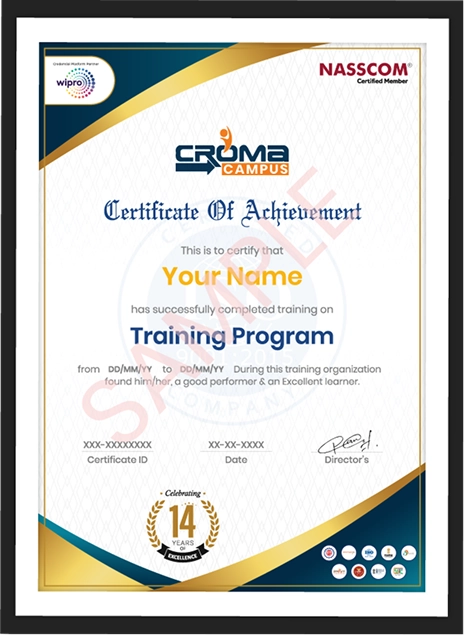- 2 Live Project
- Self-Paced/ Classroom
- Certification Pass Guaranteed
Course Offered By
Develop a solid foundation of Google Cloud architecture.
Practical application of Compute, Storage, and Networking services.
Acquire advanced tools like BigQuery, Dataflow, and TensorFlow.
Host applications on GCP with live monitoring.
Apply IAM policies for safe access and encryption.
Acquire skill through industry-level projects.
Live online and offline classes by trainers.
Immediate practice on the Google Cloud Console.
Access to lab facilities 24/7 for limitless learning.
Real-life case studies and project-based training.
Mock tests for Google Cloud certifications.
Placement assistance, resume writing, and interview sessions.
Engineering and IT students (B.Tech, BCA, MCA, etc.)
Fresh graduates searching for IT/cloud jobs.
Software developers making a switch to cloud projects.
Network engineers and system administrators.
Data engineers, database administrators, data analysts.
Greater requirement for GCP certified professionals in Ahmedabad.
Certifications are valued by employers across the globe.
Provides scope in AI, Big Data, and Machine Learning.
Good freelancing & consultancy scope for migrations and hybrid solutions.
Introduction to Cloud and GCP: Fundamentals, virtualization, cloud service models, and GCP configuration.
Compute Services: App Engine, Compute Engine, Kubernetes Engine.
Networking: VPC (Virtual Private Cloud), Load Balancing, Cloud Interconnect.
Storage Services: Cloud Storage, Filestore, Persistent Disks.
Databases: Cloud SQL, Spanner, Bigtable, and Firestore.
Security and IAM: IAM policies, identity roles, firewalls, encryption methods.
Data and AI: BigQuery, TensorFlow, ML APIs, Pub/Sub, Dataflow.
DevOps and Automation: CI/CD pipelines, Cloud Build, Cloud Functions.
Monitoring and Debugging: Using Stackdriver for logging, monitoring, and alerts.
Capstone Project: Complete implementation of an end-to-end cloud solution using all modules.
Associate Cloud Engineer.
Professional Cloud Architect.
Professional Data Engineer.
Professional Cloud Security Engineer.
Professional DevOps Engineer.
Freshers generally get 4.5 to 6 LPA.
With the certification, packages go up to 8 to 10 LPA.
Having experience of 2 to 3 years, salaries go up to 12 to 15 LPA.
Freelancing experts get money on a project-by-project basis and tend to earn more than in salaried designations.
Begin your cloud career as Cloud Support Engineer.
Graduate to positions such as Cloud Engineer / Data Engineer.
Promote to Cloud Architect / DevOps Engineer.
Secure high-level positions in MNCs worldwide.
Specialize deeper in Big Data, AI/ML, and Google Cloud advanced services.
Increased job opportunities for GCP professionals within Ahmedabad's IT economy.
Affordable course price in relation to larger metro cities.
Placement by IT firms and start-ups in Gujarat.
Practical training with project-based hands-on practice.
Cloud Engineer.
Data Engineer.
DevOps Engineer.
Cloud Security Engineer.
Cloud Application Developer.
Deploying and managing scalable applications on GCP services.
Creating secure cloud networks and VPCs.
Implementing IAM roles, encryption, and policies for security.
Implementing workflows in Cloud Functions, CI/CD pipelines.
Monitoring and optimizing systems with Stackdriver.
IT and Software Services.
Banking and Financial Services.
E-commerce and Retail.
Healthcare and Pharmaceuticals.
AI, Big Data, and ML-based Startups.
Telecom and Networking.
Experts who are working on real-time GCP with certifications are the trainers.
Strong emphasis on experiential practical learning.
Resume, certification exam, and interview guidance.
Low course fees with payment facilities.
Convenient batches: weekdays, weekends, and fast-track.
Lifetime access to study material and recorded classes.
we train you to get hired.
we train you to get hired.
By registering here, I agree to Croma Campus Terms & Conditions and Privacy Policy
Creating projects
Assigning users to predefined IAM roles within a project
Managing users in Cloud Identity (manually and automated)
Enabling APIs within projects
Provisioning one or more Stackdriver workspaces
Creating one or more billing accounts
Linking projects to a billing account
Establishing billing budgets and alerts
Setting up billing exports to estimate daily/monthly charges
Selecting appropriate compute choices for a given workload (e.g., Compute Engine, Google Kubernetes Engine, App Engine, Cloud Run, Cloud Functions)
Using preemptible VMs and custom machine types as appropriate
Product choice (e.g., Cloud SQL, BigQuery, Cloud Spanner, Cloud Bigtable)
Choosing storage options (e.g., Standard, Nearline, Coldline, Archive)
Differentiating load balancing options
Identifying resource locations in a network for availability
Configuring Cloud DNS
Launching a compute instance using Cloud Console and Cloud SDK (gcloud) (e.g., assign disks, availability policy, SSH keys)
Creating an autoscaled managed instance group using an instance template
Generating/uploading a custom SSH key for instances
Configuring a VM for Stackdriver monitoring and logging
Assessing compute quotas and requesting increases
Installing the Stackdriver Agent for monitoring and logging
Deploying a Google Kubernetes Engine cluster
Deploying a container application to Google Kubernetes Engine using pods
Configuring Google Kubernetes Engine application monitoring and logging
Deploying an application, updating scaling configuration, versions, and traffic splitting
Deploying an application that receives Google Cloud events (e.g., Cloud Pub/Sub events, Cloud Storage object change notification events)
Initializing data systems with products (e.g., Cloud SQL, Cloud Datastore, BigQuery, Cloud Spanner, Cloud Pub/Sub, Cloud Bigtable, Cloud Dataproc, Cloud Dataflow, Cloud Storage)
Loading data (e.g., command line upload, API transfer, import/export, load data from Cloud Storage, streaming data to Cloud Pub/Sub)
Creating a VPC with subnets (e.g., custom-mode VPC, shared VPC)
Launching a Compute Engine instance with custom network configuration (e.g., internal-only IP address, Google private access, static external and private IP address, network tags)
Creating ingress and egress firewall rules for a VPC (e.g., IP subnets, tags, service accounts)
Creating a VPN between a Google VPC and an external network using Cloud VPN
Creating a load balancer to distribute application network traffic to an application (e.g., Global HTTP(S) load balancer, Global SSL Proxy load balancer, Global TCP Proxy load balancer, regional network load balancer, regional internal load balancer)
Browsing Cloud Marketplace catalog and viewing solution details
Deploying a Cloud Marketplace solution
Developing Deployment Manager templates
Launching a Deployment Manager template
Managing a single VM instance (e.g., start, stop, edit configuration, or delete an instance)
SSH/RDP to the instance
Attaching a GPU to a new instance and installing CUDA libraries
Viewing current running VM inventory (instance IDs, details)
Working with snapshots (e.g., create a snapshot from a VM, view snapshots, delete a snapshot)
Working with images (e.g., create an image from a VM or a snapshot, view images, delete an image)
Working with instance groups (e.g., set autoscaling parameters, assign instance template, create an instance template, remove instance group)
Working with management interfaces (e.g., Cloud Console, Cloud Shell, GCloud SDK)
Viewing current running cluster inventory (nodes, pods, services)
Working with node pools (e.g., add, edit, or remove a node pool)
Working with pods (e.g., add, edit, or remove pods)
Working with services (e.g., add, edit, or remove a service)
Working with stateful applications (e.g. persistent volumes, stateful sets)
Working with management interfaces (e.g., Cloud Console, Cloud Shell, Cloud SDK)
Adjusting application traffic splitting parameters
Setting scaling parameters for autoscaling instances
Working with management interfaces (e.g., Cloud Console, Cloud Shell, Cloud SDK)
Moving objects between Cloud Storage buckets
Converting Cloud Storage buckets between storage classes
Setting object life cycle management policies for Cloud Storage buckets
Executing queries to retrieve data from data instances (e.g., Cloud SQL, BigQuery, Cloud Spanner, Cloud Datastore, Cloud Bigtable)
Estimating costs of a BigQuery query
Backing up and restoring data instances (e.g., Cloud SQL, Cloud Datastore)
Reviewing job status in Cloud Dataproc, Cloud Dataflow, or BigQuery
Working with management interfaces (e.g., Cloud Console, Cloud Shell, Cloud SDK)
Adding a subnet to an existing VPC
Expanding a subnet to have more IP addresses
Reserving static external or internal IP addresses
Working with management interfaces (e.g., Cloud Console, Cloud Shell, Cloud SDK)
Creating Stackdriver alerts based on resource metrics
Configuring log sinks to export logs to external systems (e.g., onpremises or BigQuery)
Viewing specific log message details in Stackdriver
Using cloud diagnostics to research an application issue (e.g., viewing Cloud Trace data, using Cloud Debug to view an application point-intime)
Viewing Google Cloud Platform status
Working with management interfaces (e.g., Cloud Console, Cloud Shell, Cloud SDK)
Viewing IAM role assignments
Assigning IAM roles to accounts or Google Groups
Defining custom IAM roles
Managing service accounts with limited privileges
Assigning a service account to VM instances
Granting access to a service account in another project
Business use cases and product strategy
Cost optimization
Supporting the application design
Integration with external systems
Movement of data
Design decision trade-offs
Build, buy, or modify
Success measurements (e.g., key performance indicators [KPI], return on investment [ROI], metrics)
Compliance and observability
High availability and failover design
Elasticity of cloud resources
Scalability to meet growth requirements
Performance and latency
Integration with on-premises/multi-cloud environments
Cloud-native networking (VPC, peering, firewalls, container networking)
Choosing data processing technologies
Choosing appropriate storage types (e.g., object, file, RDBMS, NoSQL, New SQL)
Choosing compute resources (e.g., pre-emptible, custom machine type, specialized workload)
Mapping compute needs to platform products
Integrating solution with existing systems
Migrating systems and data to support the solution
Licensing mapping
Network planning
Testing and proof of concept
Dependency management planning
Cloud and technology improvements
Business needs evolution
Evangelism and advocacy
Extending to on-premises (hybrid networking)
Extending to a multi-cloud environment that may include GCP to GCP communication
Security and data protection
Data storage allocation
Data processing/compute provisioning
Security and access management
Network configuration for data transfer and latency
Data retention and data life cycle management
Data growth management
Compute system provisioning
Compute volatility configuration (preemptible vs. standard)
Network configuration for compute nodes
Identity and access management (IAM)
Resource hierarchy (organizations, folders, projects)
Data security (key management, encryption)
Penetration testing
Separation of duties (SoD)
Security controls (e.g., auditing, VPC Service Controls, organization policy)
Managing customer-managed encryption keys with Cloud KMS
Legislation (e.g., health record privacy, children’s privacy, data privacy, and ownership)
Commercial (e.g., sensitive data such as credit card information handling, personally identifiable information [PII])
Industry certifications (e.g., SOC 2)
Audits (including logs)
Software development life cycle plan (SDLC)
Continuous integration / continuous deployment
Troubleshooting / post mortem analysis culture
Testing and validation
Service catalogue and provisioning
Business continuity and disaster recovery
Stakeholder management (e.g. influencing and facilitation)
Change management
Team assessment / skills readiness
Decision-making process
Customer success management
Cost optimization / resource optimization (capex / opex)
Application development
API best practices
Testing frameworks (load/unit/integration)
Data and system migration tooling
Local installation
Google Cloud Shell
Discover SLIs (availability, latency, etc.)
Define SLOs and understand SLAs
Agree to consequences of not meeting the error budget
Construct feedback loops to decide what to build next
Toil automation
Manage a service (e.g., introduce a new service, deploy it, maintain and retire it)
Plan for capacity (e.g., quotas and limits management)
Prevent burnout (e.g., set up automation processes to prevent burnout)
Foster a learning culture
Foster a culture of blamelessness
Immutable artifacts with Container Registry
Artifacts repositories with Container Registry
Deployment strategies with Cloud Build, Spinnaker
Deployment to hybrid and multi-cloud environments with Anthos, Spinnaker, Kubernetes
Artifacts versioning strategy with Cloud Build, Container Registry
CI/CD pipeline triggers with Cloud Source Repositories, Cloud Build GitHub App, Cloud Pub/Sub
Testing a new version with Spinnaker
Configure deployment processes (e.g., approval flows
CI with Cloud Build
CD with Cloud Build
Open source tooling (e.g. Jenkins, Spinnaker, Git Lab, Concourse)
Auditing and tracing of deployments (e.g., CSR, Cloud Build, Cloud Audit Logs)
Secure storage methods
Secret rotation and configuration changes
Terraform / Cloud Deployment Manager
Infrastructure code versioning
Make infrastructure changes safer
Immutable architecture
Centralized tools vs. multiple tools (single vs multi-tenant)
Security of CI/CD tooling
Decide on the number of environments and their purpose
Create environments dynamically per feature branch with GKE, Cloud Deployment Manager
Local development environments with Docker, Cloud Code, Scaffold
Vulnerability analysis with Container Registry
Binary Authorization
IAM policies per environment
Collecting logs from Compute Engine, GKE with Stackdriver Logging, Fluentd
Collecting third-party and structured logs with Stackdriver Logging, Fluentd
Sending application logs directly to Stackdriver API with Stackdriver Logging
Collecting metrics from Compute Engine
Collecting GKE/Kubernetes metrics
Use metric explorer for ad hoc metric analysis
Creating a monitoring dashboard
Filtering and sharing dashboards
Configure third-party alerting in Stackdriver Monitoring (i.e., Pager Duty, Slack, etc.)
Define alerting policies based on SLIs with Stackdriver Monitoring
Automate alerting policy definition with Cloud DM or Terraform
Implementing SLO monitoring and alerting with Stackdriver Monitoring
Understand Stackdriver Monitoring integrations (e.g., Grafana, BigQuery)
Using SIEM tools to analyze audit/flow logs (e.g., Splunk, Data dog)
Design Stackdriver Workspace strategy
Enabling data access logs (e.g., Cloud Audit Logs)
Enabling VPC flow logs
Viewing logs in the GCP Console
Using basic vs. advanced logging filters
Implementing logs-based metrics
Understanding the logging exclusion vs. logging export
Selecting the options for logging export
Implementing a project-level / org-level export
Viewing export logs in Cloud Storage and BigQuery
Sending logs to an external logging platform
Set ACL to restrict access to audit logs with IAM, Stack driver Logging
Set ACL to restrict export configuration with IAM, Stack driver Logging
Set ACL to allow metric writing for custom metrics with IAM, Stack driver Monitoring
Evaluate and understand user impact (Stackdriver Service Monitoring for App Engine, Istio)
Utilize Stackdriver to identify cloud resource utilization
Utilize Stackdriver Trace/Profiler to profile performance characteristics
Interpret service mesh telemetry
Troubleshoot issues with the image/OS
Troubleshoot network issues (e.g., VPC flow logs, firewall logs, latency, view network details)
Application instrumentation
Stackdriver Debugger
Stackdriver Logging
Stackdriver Trace
Debugging distributed applications
App Engine local development server
Stackdriver Error Reporting
Stackdriver Profiler
Identify resource costs
Identify resource utilization levels
Develop plan to optimize areas of greatest cost or lowest utilization
Manage pre-emptible VMs
Work with committed-use discounts
TCO considerations
Consider network pricing
Define roles (incident commander, communication lead, operations lead)
Handle requests for impact assessment
Provide regular status updates, internal and external
Record major changes in incident state (When mitigated When all clear etc.)
Establish communications channels (email, IRC, Hangouts, Slack, phone, etc.)
Scaling response team and delegation
Avoid exhaustion / burnout
Rotate / hand over roles
Manage stakeholder relationships
Identify probable causes of service failure
Evaluate symptoms against probable causes; rank probability of cause based on observed behavior
Perform investigation to isolate most likely actual cause
Identify alternatives to mitigate issue
Roll back release
Drain / redirect traffic
Turn off experiment
Add capacity
Code change / fix bug
Verify fix
Declare all-clear
Document root causes
Create and prioritize action items
Communicate post-mortem to stakeholders
Data Processing Concepts
Data Processing Pipelines
About GCP
Data Storage in GCP
Working with Data
Cloud Storage
Data Transfer Services
Cloud Fire Store
Cloud Spanner
Cloud Memory Store
Different Memory options
Compare storage options
Mapping storage systems to business requirements
Data modeling
Trade-offs involving latency, throughput, transactions
Distributed systems
Schema design
MapReduce
Hadoop & HDFS
Apache Pig
Apache Spark
Apache Kafka
Pub/sub basics
pub/Sub Terminologies
Advanced Pub/Sub Concepts
Working with Pub/Sub
Introduction to Data flow
Pipeline Lifecycle
Dataflow pipeline concepts
Advanced Dataflow concepts
Dataflow security and access
Using Dataflow
Dataproc Basics
Working with Dataproc
Advanced Dataproc
Big Table Concepts
Big Table Architecture
Big Table Data Model
Big Table Schema Design
Big Table Advanced Concepts
BigQuery Basics
Using BigQuery
Partitioning and Clustering
Best Practices
Securing BigQuery
BigQuery Monitoring and Logging
Machine Learning with BigQuery ML
Working with BigQuery
Advanced BigQuery Concepts
Datalab Concepts
Working with Datalab
Reporting & Business intelligence
Data Distribution
Introduction to Cloud Data Studio
Charts and Filters
Orchestration with Cloud Composer
Cloud Composer Overview
Cloud Composer Architecture
Working with Cloud Composer
Advanced Cloud Composer Concepts
Choice of infrastructure
System availability and fault tolerance
Use of distributed systems
Capacity planning
Hybrid cloud and edge computing
Architecture options (e.g., message brokers, message queues, middleware, service-oriented architecture, serverless functions)
At least once, in-order, and exactly once, etc., event processing
Awareness of current state and how to migrate a design to a future state
Migrating from on-premises to cloud (Data Transfer Service, Transfer Appliance, Cloud Networking)
Validating a migration
Cloud Managed Services
Effectives Use of Managed Services
Storage Cost and performance
Lifecycle Management of Data
Data cleansing
Batch and streaming
Transformation
Data acquisition and import
Integrating with new data sources
Provisioning resources
Monitoring pipelines
Adjusting pipelines
Testing and quality control
Machine Learning Introduction
Machine Learning Basics
Machine Learning Types and Models
Overfitting
Hyperparameters
Feature Engineering
Deep Learning with TensorFlow
Introduction to Artificial Neural Networks
Neural Network Architectures
Building a Neural Network
ML APIs (e.g., Vision API, Speech API)
Customizing ML APIs (e.g., AutoML Vision, Auto ML text)
Conversational experiences (e.g., Dialogflow)
Ingesting appropriate data
Retraining of machine learning models (Cloud Machine Learning Engine, BigQuery ML, Kubeflow, Spark ML)
Continuous evaluation
Distributed vs. single machine
Use of edge compute
Hardware accelerators (e.g., GPU, TPU)
Machine learning terminology (e.g., features, labels, models, regression, classification, recommendation, supervised and unsupervised learning, evaluation metrics)
Impact of dependencies of machine learning models
Common sources of error (e.g., assumptions about data)
we train you to get hired.
Phone (For Voice Call):
+91-971 152 6942WhatsApp (For Call & Chat):
+91-971 152 6942Stories
success
inspiration
career upgrade
career upgrade
career upgrade
career upgrade
You will get certificate after
completion of program
You will get certificate after
completion of program
You will get certificate after
completion of program
in Collaboration with

Empowering Learning Through Real Experiences and Innovation
we train you to get hired.
Phone (For Voice Call):
+91-971 152 6942WhatsApp (For Call & Chat):
+91-971 152 6942Get a peek through the entire curriculum designed that ensures Placement Guidance
Course Design By
Course Offered By
Ready to streamline Your Process? Submit Your batch request today!
Yes. GCP Courses in Ahmedabad start with fundamentals before slowly covering advanced material, making it suitable for beginners.
The course length is typically 2–3 months, based on weekday/weekend batch selection.
Yes. Students receive a training completion certificate and support for official GCP certifications.
Projects vary from app deployment, network management, CI/CD automation, and BigQuery-based data analysis.
Yes. Placement and career counseling (resume preparation, interviewing, job networking) are arranged after finishing the course.
Highest Salary Offered
Average Salary Hike
Placed in MNC’s
Year’s in Training

fast-tracked into managerial careers.
Get inspired by their progress in the
Career Growth Report.
FOR QUERIES, FEEDBACK OR ASSISTANCE
Best of support with us
For Voice Call
+91-971 152 6942For Whatsapp Call & Chat
+91-9711526942





















